Knowledge
Rose Tea
Introduction:
Rose tea is made of the buds of roses of Rosaceae, mainly produced in Pingyin, Shandong, China.
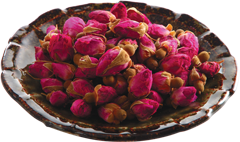 Functions:
Functions:
Rose tea has blood-activating, qi-activating, liver-soothing, depression-relieving, blood-harmonizing, and stasis-removing properties. It can promote the metabolism, blood and breath harmanizing, providing youthful complexion, and prevent constipation.
Characteristics:
Tastes sweet, in warm nature.
Processing method:
Rinse the rose tea with clear water, and then brew or boil the tea in hot water.
Way of storage:
Rose tea should be stored in a ventilated and cool place.
Other notes:
- Rose tea has a strong fragrance. It is clear, mild, liver-soothing, and stomach-enlivening. When drunk, its aroma and sweet taste can refresh the drinker's mind. It has been a prestigious drink for thousands of years. Frequent drinking of rose tea can clear blood fats, improve blood circulation, promote the metabolism, and give the drinker a rosy complexion.
- In addition to its value as tea, rose also has ornamental value. Gazing at the rose flower buds brewing in the transparent glass and smelling its fragrance, the drinker is immersed in a warm and peaceful state.
Honeysuckle
Introduction:
Honeysuckles, also called rendonghua in Chinese, are the buds and early blooming flowers of caprifoliaceae, mainly from Sichuan and Henan, China.
 Functions:
Functions:
Honeysuckles can remove heat and toxins, detoxifying, and wind-heat-dispersing properties. They are suitable for people with sore throats, external contraction of wind-heat, sores, or acute enteritis. They can be served as an herbal tea and consumed to prevent heat stroke, the common cold, and communicable diseases of the intestines.
Characteristics:
Tastes sweet, in cold nature.
Processing method:
Rinse the honeysuckles with clear water, and then brew or boil the tea in hot water.
Way of storage:
Honeysuckles should be kept in a ventilated and cool place. If they are to be consumed over a long period of time, it is suggested that they are sealed and chilled (at 0-8°C) .
Suggested Serving:
Honeysuckles (20g), Hangzhou white chrysanthemum (40g), raw licorice roots (8g), rock sugar (to taste) → used as ingredients of a drink. According to dietotherapy, the drink is heat-removing, heatstroke-relieving, wind-dispersing, and vision-improving .
Chrysanthemum
Introduction:
Chrysanthemum is the dried capitulum of chrysanthemums of Asteraceae, mainly from Zhejiang, China.
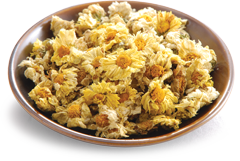 Functions:
Functions:
Chrysanthemum has wind-dispersing, heat-dissipating, liver-nourishing, vision-improving, heat-removing, and detoxifying properties, suitable for people with symptoms including dizziness, red eyes, thirst, vexation, and external contraction of wind-heat.
Characteristics:
Tastes sweet, in cold nature。
Processing method:
Rinse the Hangzhou white chrysanthemum with clear water, and then brew or boil the tea in hot water.
Way of storage:
Hangzhou white chrysanthemum should be stored in a ventilated and cool place. If they are to be consumed over a long time, it is suggested that they are sealed and chilled (at 0-8°C).
Suggested Serving:
Hangzhou white chrysanthemum (75g), genuine American ginseng slices (20g), honey (to taste) → used as ingredients of a drink. According to dietotherapy, the drink is qi-replenishing, fluid-engendering , heat-clearing, and vision-improving.
Baby Chrysanthemum
Introduction:
Baby chrysanthemum is the dried capitulum of chrysanthemums. It is made from selected authentic Hangzhou white chrysanthemum buds from Tongxiang, Zhejiang using an advanced drying technique.
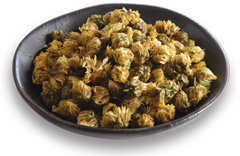 Functions:
Functions:
Baby chrysanthemum has heat-removing, detoxifying, liver-nourishing, vision-improving, throat-moistening, and fluid-engendering properties. It is suitable for people suffering from damaged yin, thirst, and vexation. Frequent drinking can refresh the drinker's heart and soothe the mind. It is really an must-have drink to have at home or trip.
Characteristics:
Tastes sweet, in cold nature.
Processing method:
Rinse the baby chrysanthemum with clear water, and then make tea or boil with water.
Way of storage:
Baby chrysanthemum should be stored in a ventilated and cool place. If they are to be consumed over a long time, it is suggested that they are sealed and chilled (at 0-8°C).
Suggested Serving:
When brewing tea with baby chrysanthemum, add 10-20 baby chrysanthemum flowers to your taste into a glass, pour in 100°C boiled water, and brew them for 3-5 minutes. Add rock sugar to your taste and the tea will be ready to serve. The tea can also be brew with American ginseng, fructus or other tea, as you prefer.
Burdock Tea
Introduction:
Burdock tea is made from burdock of herbaceous Asteraceae, known as Arctium lappa, also called Japanese ginseng. Its name in Chinese, niubang, comes from its cow tail appearance. Burdock is mainly produced in Shandong, China.
 Functions:
Functions:
Burdock tea has heat-removing, detoxifying, diuresis-inducing, and edema-alleviating properties. It contains various amino acids and abundant inulin, and is therefore suitable for patients with diabetes.
Characteristics:
Tastes sweet, in cold nature.
Processing method:
Rinse the burdock tea with clear water, and then brew or boil the tea in hot water.
Way of storage:
Burdock tea should be stored in a ventilated and cool place. If it is to be consumed over a long period of time, it is suggested that the product is sealed and chilled (at 0-8°C).
Suggested Serving:
Burdock tea (40g), Canada ginseng slices (12g ), caricas (6 pieces), lean pork (605g) → used as ingradients of a soup. According to dietotherapy, the soup is heat-removing, fluid-engendering, spleen-fortifying, and stomach-nourishing .
Xi Hu Longjing
Introduction:
Longjing is a green tea, which is an unfermented tea. It is mainly produced in West Lake, Zhejiang, China. The finished tea leaf is flat in shape, tender and straight, and of yellowish green color. Its quality is characterized by a slight fragrance and a mellow flavor. The brewed tea color is a yellowish emerald green. The tea is famous for its "green color, pleasing flagrance, sweet flavor, and preciousness." Of all Longjing teas, the Xi Hu Longjing picked and processed before the Ching Ming Festival is the best in quality. This tea is called Pre-Qingming Xi Hu Longjing.
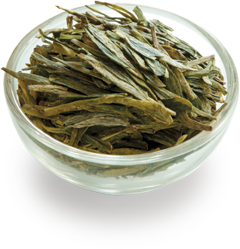 Functions:
Functions:
Xi Hu Longjing has vision-improving, anti-oxidating, immunity-enhancing, and enhanced carcliovasular properties. Longjing tea contains rich tea polyphenol, amino acids, vitamins, and various salubrious Minerals. It is the tea that has the highest content of nutritious ingredients among all teas.
Characteristics:
Sweet in taste, mild in nature.
Processing method:
When brewing Longjing tea, it is suggested that a transparent glass or a ceramic cup be used. Take 2-3g tea (just a little dash by 3 fingers), pour in hot boiled water (preferably 90°C ), brew it for 3-5 minutes, and the tea is ready to serve.
Tieguanyin
Introduction:
Tieguanyin is an Oolong tea, also called green tea. It is a semi-fermented tea between green tea and black tea and has the characteristics of both. Tieguanyin is mainly produced in Anxi, Fujian, China. Its name comes from its iron-like weight and its beauty reminiscent of Guanyin.
There are two types of Tieguanyin, which are Heavy Smell Type and Slight Smell Type, and both have their own characteristics:
- Heavy Smell Type. This is the traditional type of Tieguanyin. It has been parched over fire at high temperature for a long time, so the tea has a obvious smoky flavor and a mellow taste. The tea leaf is black and the yellowish green brewed tea has a long-lasting fragrance and a persistently sweet aftertaste.
- Slight Smell Type. This is the most popular type nowadays. It gives off an appealing fragrance when the tea is being brewed. The tea granules are green and compact, with a slight fragrance. The brewed tea is transparent yellow and has a mellow taste and flowery flavor. It is said, "The fragrance remains even after seven-time brews."
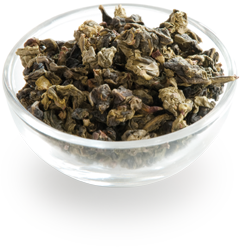 Characteristics:
Characteristics:
Tieguanyin has fat-removing, heart-strengthening, heat-removing, and enhanced cardiovasular properties. It contains rich tea polyphenols, amino acids, vitamins, and various minerals.
Processing method:
Boil the water and heat the tea set first. Then take a small bag of tea (10g) and pour in boiled water, immediately draining the water. This is called "rinsing the tea." After this, pour in boiling water and brew for one minute, and the tea will be ready to serve. The tea can be brewed several times, according to taste.
If the tea is brewed with an earthenware tea set, the flavor will be even better.
Way of storage:
Tieguanyin should be sealed and stored in a cool and dry place . If the tea is to be consumed over a long period, it should be sealed and chilled (at 0-8°C) .
Suggested Serving:
Tieguanyin is the best quality Oolong tea. The finished tea leaf has a firm and thick shape and is heavy and evenly sized. With regard to its quality, it is as sweet and mellow as a black tea and also has the fragrance of a green tea. After brewing, the tea leaves are characterized by green stalks, green leaves, and red leaf edges.
The tea water tastes mellow and thick, sweet and fresh. The tea is popular because of its fragrance and long-lasting sweet aftertaste.
